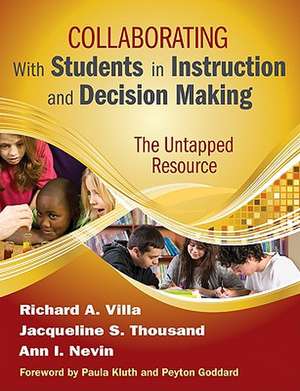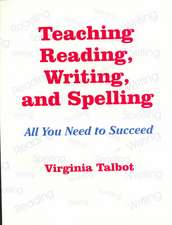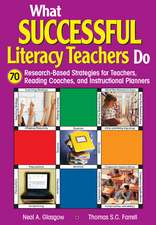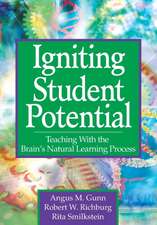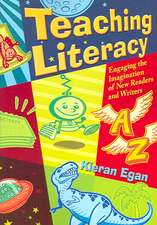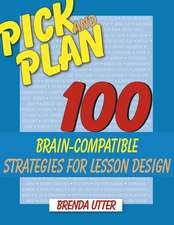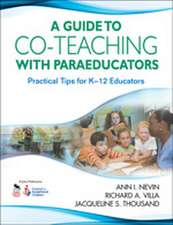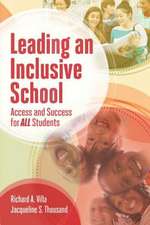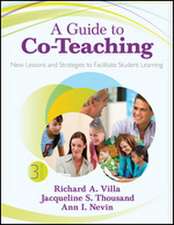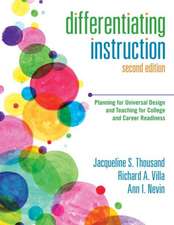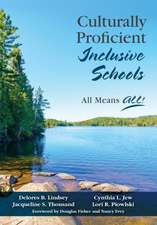Collaborating With Students in Instruction and Decision Making: The Untapped Resource
Editat de Richard A. Villa, Jacqueline S. Thousand, Ann I. Nevinen Limba Engleză Paperback – 7 iun 2010
- Assessment tools
- Lesson plans in user-friendly formats
- Many personal case studies
Collaborating With Students in Instruction and Decision Making provides easy-to-implement methods that can be used in classrooms, school buildings, or across school districts. The book's content is ideal for staff development personnel and school district curriculum specialists as well as faculty in colleges of education dedicated to the development of the teaching, decision making, and the advancement of students' advocacy skills.
Preț: 325.97 lei
Nou
Puncte Express: 489
Preț estimativ în valută:
62.39€ • 67.80$ • 52.44£
62.39€ • 67.80$ • 52.44£
Carte tipărită la comandă
Livrare economică 21 aprilie-05 mai
Preluare comenzi: 021 569.72.76
Specificații
ISBN-13: 9781412972178
ISBN-10: 1412972175
Pagini: 248
Dimensiuni: 216 x 279 x 15 mm
Greutate: 0.68 kg
Ediția:New.
Editura: SAGE Publications
Colecția Corwin
Locul publicării:Thousand Oaks, United States
ISBN-10: 1412972175
Pagini: 248
Dimensiuni: 216 x 279 x 15 mm
Greutate: 0.68 kg
Ediția:New.
Editura: SAGE Publications
Colecția Corwin
Locul publicării:Thousand Oaks, United States
Recenzii
"The authors brilliantly bring the reader's focus down to the core of the educational process: the student. This powerful focus on the purposeful engagement of students in their own learning process guides us through reflection, cooperative learning groups, planning, choice, a sense of belonging, and advocacy, as well as social, emotional, academic, and life-skills issues. Resources abound in this contribution to the dialogue of increasing student achievement and well being while reflecting on the whole student."
"How powerful learning could be if students and educators shared more of the teaching responsibilities! Educators who use even a few ideas from this text will find their teaching and learning experiences greatly enhanced and far more enjoyable. Best of all, involving students in the teaching experience helps them learn more academically and do more socially."
"In this easy-to-read resource, the authors help educators understand that inclusion isn’t something that we do to and for students, but rather, something we must do with students. The powerful anecdotes of educators and students planning, tutoring, and teaching side by side give us new hope and further direction for the creation of inclusive schools."
"This book is a must-read for every administrator seeking to build a school that meets the needs of diverse learners. Villa, Thousand, and Nevin practically and purposefully demonstrate how the reallocation of existing resources can be instrumental in ‘re-forming’ schools. The descriptive, step-by-step planning guides empower administrators, new and experienced, to redesign their school community in a way that will increase student achievement without increasing the budget!"
"This book emphasizes the work of students as significant members of the school and classroom community, not just as recipients of the work that teachers do, but as an integral part that can benefit from the teaching as well as be part of the teaching force. I loved the emphasis on empowering students in this co-teaching arrangement. I also appreciated the focus on listening to students' voices so the work of teachers is based on what students really need. The authors provide knowledgeable and practical advice for personalizing and individualizing instruction for all students while maintaining high expectations."
"Classrooms go further when they are student-driven, and this book provides amazing resources and ideas to empower both students and teachers. From providing a rationale for teacher/student collaboration to helping with the nuts and bolts of the actual work, the authors have written a practical, useful, and inspiring guide for collaboration."
"How powerful learning could be if students and educators shared more of the teaching responsibilities! Educators who use even a few ideas from this text will find their teaching and learning experiences greatly enhanced and far more enjoyable. Best of all, involving students in the teaching experience helps them learn more academically and do more socially."
"In this easy-to-read resource, the authors help educators understand that inclusion isn’t something that we do to and for students, but rather, something we must do with students. The powerful anecdotes of educators and students planning, tutoring, and teaching side by side give us new hope and further direction for the creation of inclusive schools."
"This book is a must-read for every administrator seeking to build a school that meets the needs of diverse learners. Villa, Thousand, and Nevin practically and purposefully demonstrate how the reallocation of existing resources can be instrumental in ‘re-forming’ schools. The descriptive, step-by-step planning guides empower administrators, new and experienced, to redesign their school community in a way that will increase student achievement without increasing the budget!"
"This book emphasizes the work of students as significant members of the school and classroom community, not just as recipients of the work that teachers do, but as an integral part that can benefit from the teaching as well as be part of the teaching force. I loved the emphasis on empowering students in this co-teaching arrangement. I also appreciated the focus on listening to students' voices so the work of teachers is based on what students really need. The authors provide knowledgeable and practical advice for personalizing and individualizing instruction for all students while maintaining high expectations."
"Classrooms go further when they are student-driven, and this book provides amazing resources and ideas to empower both students and teachers. From providing a rationale for teacher/student collaboration to helping with the nuts and bolts of the actual work, the authors have written a practical, useful, and inspiring guide for collaboration."
Cuprins
Foreword: The Importance of Students' Voices by Paula Kluth and Peyton Goddard
List of Tables
List of Figures
Acknowledgments
About the Authors
I. Introduction
Letter to the Reader
1. Why Collaborate with Students?
Rationale #1: Student Collaboration Facilitates 21st Century Goals of Education
Rationale#2: Student Collaboration is Democratic Schooling
Rationale #3: Student Collaboration Increases Self-Determination
Rationale #4: Student Collaboration Increases Academic and Social Competence
Rationale #5: Student Collaboration Facilitates Other School Reform Efforts
Rationale #6: Student Collaboration is an Untapped Resource in Times of Limited Fiscal and Human Resources
Summary
II. Teaching With Students
Definition of Teaching
What is the Instructional Cycle?
What is the Research Base for Teaching with Students?
2. Students as Co-Teachers in Cooperative Learning Groups
What is Cooperative Learning?
What Cooperative Groups Are NOT
Five Essential Ingredients of Cooperative Group Learning: PIGS Face
The Four Phases of Planning and Implementing Formal Cooperative Group Lessons
Teacher Decisions at Each Phase of Planning and Implementation
An Example of a Formal Cooperative Group Lesson
What Do Students Say About Cooperative Group Learning
Summary
3. Students as Peer Tutors and Partner Learners
Meet Some Peer Tutors
What is Peer Tutoring/Partner Learning?
Essential Ingredients of Peer Tutoring and Partner Learning
Getting Started with Peer Tutoring and Partner Learning
An Example of a Peer Tutoring/Partner Learning Lesson
Students' Views of Peer Tutoring and Partner Learning
Summary
4. Students as Co-Teachers
What is a Co-Teacher? What are Examples of Adults Co-Teaching with Students?
Co-Teaching Approaches
Challenges Faced by Student Co-Teachers
What Are Student Co-Teachers, Adult Co-Teachers, Administrators, and Learners in Co-Taught Classes Saying About Co-Teaching?
Summary
III. Decision-Making With Students
5. Empowering Students as Collaborative Creative Thinkers
Barriers to Creative Thinking and Action
Awareness Plans for Busting Barriers and Imagining Improvements
Osborn-Parnes Creative Problem-Solving (CPS) Process
Thinking for Collaborative Solution Finding—Focusing Upon What You Can Do
Summary
6. Students as Instructional Decision Makers
Collaborating with Students to Determine the Product of Learning
Collaborating with Students to Differentiate Instruction for Struggling Learners
Summary
7. Students as Designers of Their Own Learning
Defining and Nurturing Self-Determination
Making Action Plans (MAPs) as a Tool to Actualize Self-Determination
Student-Led Individualized Education Programs
Personal Learning Plans as a Tool to Teach Self-Determination
What Do Students Say About Self-Determination?
Summary
8. Students as Mediators of Conflict and Controversy
Examples of Everyday School Conflicts
Understanding Conflict
An Example of a Class-Wide or School-Wide Peer Mediation Program
A Lesson Plan Example: Learning Friendly Disagreeing Skills
Summary
9. Students as Collaborators in Responsibility
A "Circle of Courage" Definition of Responsibility
The Self-Discipline Pyramid
Summary
Epilogue: Beyond Benevolence to Befriending
Glossary
Resources
A. Cooperative Group Learning Lesson Plan
B. Peer Tutor Lesson Plan
C. Co-Teaching Lesson Plan
D. Syllabus for High School Course for Teaching Students to Be Co-Teachers
E. Template for Product-Activity Matrix Integrating Bloom’s Taxonomy and Gardner’s Multiple Intelligence Theory
F. Template for Facts about the Learner, Classroom Demands, Mismatches, and Potential Solutions
G. Student Collaboration Quiz (for students)
References
Index
List of Tables
List of Figures
Acknowledgments
About the Authors
I. Introduction
Letter to the Reader
1. Why Collaborate with Students?
Rationale #1: Student Collaboration Facilitates 21st Century Goals of Education
Rationale#2: Student Collaboration is Democratic Schooling
Rationale #3: Student Collaboration Increases Self-Determination
Rationale #4: Student Collaboration Increases Academic and Social Competence
Rationale #5: Student Collaboration Facilitates Other School Reform Efforts
Rationale #6: Student Collaboration is an Untapped Resource in Times of Limited Fiscal and Human Resources
Summary
II. Teaching With Students
Definition of Teaching
What is the Instructional Cycle?
What is the Research Base for Teaching with Students?
2. Students as Co-Teachers in Cooperative Learning Groups
What is Cooperative Learning?
What Cooperative Groups Are NOT
Five Essential Ingredients of Cooperative Group Learning: PIGS Face
The Four Phases of Planning and Implementing Formal Cooperative Group Lessons
Teacher Decisions at Each Phase of Planning and Implementation
An Example of a Formal Cooperative Group Lesson
What Do Students Say About Cooperative Group Learning
Summary
3. Students as Peer Tutors and Partner Learners
Meet Some Peer Tutors
What is Peer Tutoring/Partner Learning?
Essential Ingredients of Peer Tutoring and Partner Learning
Getting Started with Peer Tutoring and Partner Learning
An Example of a Peer Tutoring/Partner Learning Lesson
Students' Views of Peer Tutoring and Partner Learning
Summary
4. Students as Co-Teachers
What is a Co-Teacher? What are Examples of Adults Co-Teaching with Students?
Co-Teaching Approaches
Challenges Faced by Student Co-Teachers
What Are Student Co-Teachers, Adult Co-Teachers, Administrators, and Learners in Co-Taught Classes Saying About Co-Teaching?
Summary
III. Decision-Making With Students
5. Empowering Students as Collaborative Creative Thinkers
Barriers to Creative Thinking and Action
Awareness Plans for Busting Barriers and Imagining Improvements
Osborn-Parnes Creative Problem-Solving (CPS) Process
Thinking for Collaborative Solution Finding—Focusing Upon What You Can Do
Summary
6. Students as Instructional Decision Makers
Collaborating with Students to Determine the Product of Learning
Collaborating with Students to Differentiate Instruction for Struggling Learners
Summary
7. Students as Designers of Their Own Learning
Defining and Nurturing Self-Determination
Making Action Plans (MAPs) as a Tool to Actualize Self-Determination
Student-Led Individualized Education Programs
Personal Learning Plans as a Tool to Teach Self-Determination
What Do Students Say About Self-Determination?
Summary
8. Students as Mediators of Conflict and Controversy
Examples of Everyday School Conflicts
Understanding Conflict
An Example of a Class-Wide or School-Wide Peer Mediation Program
A Lesson Plan Example: Learning Friendly Disagreeing Skills
Summary
9. Students as Collaborators in Responsibility
A "Circle of Courage" Definition of Responsibility
The Self-Discipline Pyramid
Summary
Epilogue: Beyond Benevolence to Befriending
Glossary
Resources
A. Cooperative Group Learning Lesson Plan
B. Peer Tutor Lesson Plan
C. Co-Teaching Lesson Plan
D. Syllabus for High School Course for Teaching Students to Be Co-Teachers
E. Template for Product-Activity Matrix Integrating Bloom’s Taxonomy and Gardner’s Multiple Intelligence Theory
F. Template for Facts about the Learner, Classroom Demands, Mismatches, and Potential Solutions
G. Student Collaboration Quiz (for students)
References
Index
Descriere
Take advantage of a resource that’s right in your classroom—your students!
This book offers practical strategies for empowering students as co-teachers, decision makers, and advocates in the classroom. Ideal for K–12 general and special education teachers, this guide describes how to:
This book offers practical strategies for empowering students as co-teachers, decision makers, and advocates in the classroom. Ideal for K–12 general and special education teachers, this guide describes how to:
- Involve students in instruction through collaborative learning groups, co-teaching, and peer tutoring that foster self-discipline and responsible behavior
- Make students a part of decision making by utilizing personal learning plans, peer mediation, and more
- Use assessment tools, lesson plans, case studies, and checklists to put collaboration with students into practice
